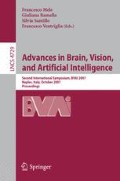Abstract
Robot self localization is a crucial issue in autonomous robotic research. In the last years, several approaches have been proposed to solve this problem. In this paper, we describe a landmark based neurosymbolic hybrid approach to tackle the global localization problem. We use the same approach to cope with the whole problem: from landmark recognition to position estimation. The map given to the robot is interpreted by a neurosymbolic system (formed by a weightless neural network and a BDI agent) for extracting landmark information. A “virtual neural sensor” is used, during robot navigation, for detecting the landmarks in the real environment. These information (map and detected landmarks) are finally processed by a unified neurosymbolic hybrid system (NSP) for determining the robot location on the given map.
Access this chapter
Tax calculation will be finalised at checkout
Purchases are for personal use only
Preview
Unable to display preview. Download preview PDF.
References
Borenstein, J., Everett, H.R., Feng, L.: Navigating Mobile Robots: Systems and Techniques. A.K. Peters, Ltd., Natick, MA, USA (1996)
Thrun, S., Burgard, W., Fox, D.: Probabilistic Robotics (Intelligent Robotics and Autonomous Agents). The MIT Press, Cambridge (2005)
Simmons, R., Koenig, S.: Probabilistic robot navigation in partially observable environments. In: Proc. of the IJCAI, pp. 1080–1087 (1995)
Fox, D., Thrun, S., Burgard, W., Dellaert, F.: Particle filters for mobile robot localization (2001)
Jensfelt, P., Wijk, O., Austin, D., Andersson, M.: Experiments on augmenting condensation for mobile robot localization. In: IEEE ICRA, pp. 2518–2524. IEEE Computer Society Press, Los Alamitos (2000)
Motomura, A., Matsuoka, T., Hasegawa, T.: Self-localization method using two landmarks and dead reckoning for autonomous mobile soccer robots. In: Polani, D., Browning, B., Bonarini, A., Yoshida, K. (eds.) RoboCup 2003. LNCS (LNAI), vol. 3020, pp. 526–533. Springer, Heidelberg (2004)
Sim, R., Dudek, G.: Learning and evaluating visual features for pose estimation. ICCV 2, 1217–1222 (1999)
Se, S., Lowe, D., Little, J.: Local and global localization for mobile robots using visual landmarks. In: Proc. of the IEEE/RSJ IROS, Hawaii, pp. 414–420 (2001)
Aleksander, I., Thomas, W., Bowden, P.: WISARD, a radical new step forward in image recognition. Sensor Rev. 4, 120–124 (1984)
Burattini, E., Coraggio, P., De Gregorio, M.: Agent WiSARD: A hybrid system for reconstructing and understanding two-dimensional geometrical figures. In: Abraham, A., Köppen, M., Franke, K. (eds.) HIS. Frontiers in Artificial Intelligence and Applications, vol. 105, pp. 887–896. IOS Press, Amsterdam (2003)
Burattini, E., De Gregorio, M., Ferreira, V.M.G., França, F.M.G.: NSP: A neuro-symbolic processor. In: Mira, J.M., Álvarez, J.R. (eds.) IWANN 2003. LNCS, vol. 2687, pp. 9–16. Springer, Heidelberg (2003)
Burattini, E., Coraggio, P., De Gregorio, M., Staffa, M.: Agent WiSARD in a 3D world. In: Mira, J.M., Álvarez, J.R. (eds.) IWINAC 2005. LNCS, vol. 3562, pp. 272–280. Springer, Heidelberg (2005)
Burattini, E., De Gregorio, M., Tamburrini, G.: Generation and classification of recall images by neurosymbolic computation. In: ECCM 1998. Second European Conference on Cognitive Modelling, pp. 127–134 (1998)
Burattini, E., de Francesco, A., De Gregorio, M.: NSL: A neuro-symbolic language for a neuro-symbolic processor (NSP). Int. J. Neural Syst. 13, 93–101 (2003)
Burattini, E., Datteri, E., Tamburrini, G.: Neuro-symbolic programs for robots. In: Proc. of the IJCAI05. Workshop on Neural-Symbolic Learning and Reasoning, Edimburgh, Scotland, pp. 7–14 (2005)
Burattini, E., De Gregorio, M., Tamburrini, G.: Neurosymbolic processing: Non-monotonic operators and their FPGA implementation. In: Fourth Brazilian Symposium on Neural Networks, Rio de Janeiro, Brasil, pp. 93–101 (2000)
Author information
Authors and Affiliations
Editor information
Rights and permissions
Copyright information
© 2007 Springer-Verlag Berlin Heidelberg
About this paper
Cite this paper
Coraggio, P., De Gregorio, M. (2007). A Neurosymbolic Hybrid Approach for Landmark Recognition and Robot Localization. In: Mele, F., Ramella, G., Santillo, S., Ventriglia, F. (eds) Advances in Brain, Vision, and Artificial Intelligence. BVAI 2007. Lecture Notes in Computer Science, vol 4729. Springer, Berlin, Heidelberg. https://doi.org/10.1007/978-3-540-75555-5_54
Download citation
DOI: https://doi.org/10.1007/978-3-540-75555-5_54
Publisher Name: Springer, Berlin, Heidelberg
Print ISBN: 978-3-540-75554-8
Online ISBN: 978-3-540-75555-5
eBook Packages: Computer ScienceComputer Science (R0)

